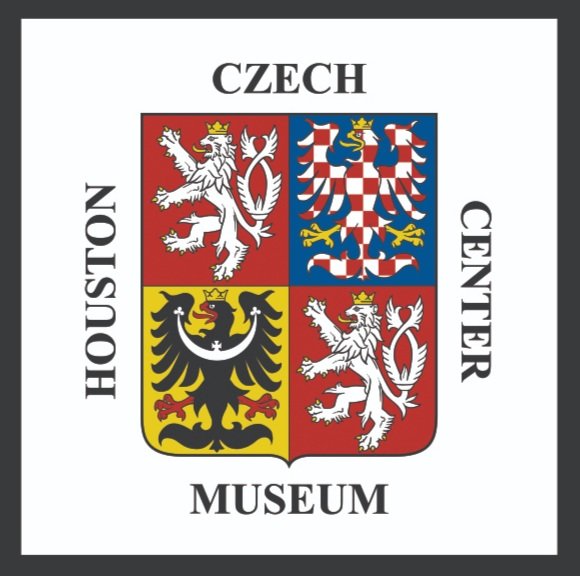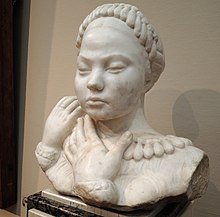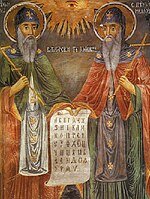The Christianization of the Czech Lands
The Cathedral of Saints Vitus Wenceslaus and Adelbert at Prague Castle
Before Christianity
Before the Czech lands were Christianized, the main religion of the area was a form of Slavic paganism. The Czech people and their ancestors followed many gods*. Not much is known about the religion because there was no Slavic written language until the ninth century, when Christian missionaries invented Glagolitic Script.
*Religions that follow multiple gods are called polytheistic religions.
Bust of the Slavic goddess Lada (2)
Slavic “Paganism”:
The term “paganism” has been up for debate in recent years, as its implications are somewhat problematic and inaccurate. For one, the term was invented by Christians to describe people who practiced traditional religions. A “pagan” would not have called themself a “pagan,” but rather they would be known as a follower of a specific cult or god. - Likewise, the term can be used to diminish the value and legitimacy of pre-Christian religions. The term has become somewhat synonymous with words like “barbaric” and “uncivilized.” This of course is incorrect. “Pagan” religions all over the world are legitimate religions that have their own set of unique values, practices, and worth.
Pagan-themed painting: "The Celebration of Svantovít. When Gods Are at War, Salvation Is in the Arts" by Alphonse Mucha 1912 (3)
Slavic Gods:
Archaeological findings and non-Slavic historical texts reveal what little is known about Slavic paganism. Important gods include:
Pernun: god of thunder & supreme god
Jarilo: god of youth and spring
Lada: goddess of love
Svantovit: god of war
Porevit: god of summer
Rujevit: god of autumn
Drawing of the god Porevit (4)
Slavic Worship:
Many aspects of the traditional religion transferred well to Christian beliefs, making for a somewhat simple transition between the religions. Important features of the traditional Slavic religion include:
Idol worship
Belief in the interconnection of the heavens, earth, and underworld
Worship in temples
ritual banquets
19th-century woodcut of Slavs worshipping (3)
The Coming of Christianity
The Christianization of the Czech Lands is attributed to Saint Cyril and Saint Methodius because of their mission to Moravia and creation of the first form of written Slavic language. However, Cyril and Methodius did not introduce Christianity to the region. Archaeological evidence has revealed that Christianity was already established in the Czech Lands before the arrival of Cyril and Methodius.
Postcard art of Saints Cyril and Methodius (5)
Christianity Before Cyril and methodius:
The remains of at least five churches exist in Moravia that date to before 863 CE, pointing to the spiritual and administrative presence of Christianity before the arrival of Cyril and Methodius. The first missionaries in Great Moravia were of Iro-Scottish origin, and arrived in the region as early as the mid-eighth century. Frankish* missions followed the original Iro-Scottish ones.
*The Franks are peoples from Francia, which was a territory including modern-day France in Northwestern Europe in the Middle Ages.
Mojmir I:
The first known ruler of Great Moravia (Mojmir I) converted to Christianity around 822 CE. Frankish bishops set up a network of Archpriests to preside over the conversion of the Moravians during this time, but existing pagan religions were still widely practiced all across the region.
Drawing of Mojmir I (6)
Cyril and methodius-faithful brothers:
Painting of Cyril and Methodius by Jan Matejko (7)
Cyril (Constantine):
Saint Cyril (born Constantine) was a philosopher, teacher, scholar, and ultimately a missionary from Thessalonica. He relocated to Constantinople, where he studied languages, became an ordained priest at the Hagia Sophia church, served as a librarian, and taught philosophy at the Magnaura university. Saint Cyril (born Constantine) was a philosopher, teacher, scholar, and ultimately a missionary from Thessalonica. He relocated to Constantinople, where he studied languages, became an ordained priest at the Hagia Sophia church, served as a librarian, and taught philosophy at the Magnaura university.
*Cyril's missions to Samarra and the Caucasus were unsuccessful because of other religions' influence in the areas. The people of Samarra were under a Muslim rule, and the Khazars of the Caucasus adopted Judaism.
*Cyril only baptized about 200 Khazars on his mission.
Methodius (Michael):
Saint Methodius (born Michael) was also born in Thessalonica. He was a monk at the Polychron Monastery in present day Turkiye. He was a dedicated Deacon and also shared his brother's interest in linguistics.
cyril and mthodius’ Mission to Moravia from byzantium:
Cyril and Methodius arrived in Moravia in 863. Because of the previous successful missions in Moravia executed by the Iro-Scottish and Franks, Cyril and Methodius’ mission was not only centered around the conversion of pagans. The second ruler of Great Moravia (Rastislav) desired the establishment of a proper bishopric administrative system* in Moravia, namely, he wanted a Bishop of Moravia.
*A bishopric administrative system is a system where bishops hold jurisdiction of an ecclesiastical district. The bishops report to a higher ecclesiastical authority, such as the Pope.
Map of Great Moravia (8)
Rastislav of Moravia-Political/Religious Endeavors:
As a ruler, Rastislav was interested in aligning his lands with the political and religious power of the Church. He sought a partnership with the Church of Rome, but his request was declined due to increasing political tensions between Moravia and the Franks. He then asked the Byzantine Church to send a bishop. The Church sent Cyril and Methodius instead. They were tasked with adding a formal liturgy and clergy to the already somewhat Christianized lands.
Rastislav depicted as an Orthodox saint (9)
impacts of the moravian mission-“the apostles of the slavs”:
Cyril and Methodius set up several churches in Moravia, and they educated many local priests. Their greatest achievement, however, was the implementation of Glagolitic Script in the region.
"Saints Cyril and Methodius holding the Cyrillic alphabet" by Z. Zograf (7)
Glagolitic Script:
Cyril’s experience as a linguist and fluency in the Slavic language allowed him and his brother to invent the Glagolitic script before arriving in Moravia. This was the first written form of the Slavic language, and they used it to translate parts of the Bible for their mission. They also gave mass in both Latin and Slavic once there. The script was based largely on Hebrew and Greek linguistic elements.
An early example of Glagolitic Script from Croatia (7)
Cyril’s words on the importance of delivering God’s word in local languages:
“Does not God’s rain fall upon all equally? And does not the sun shine also upon all? And do we not all breathe air in the same way? Are you not ashamed to mention only three tongues [Latin, Greek, and Hebrew], and to command all other nations and tribes to be blind and deaf?”
Cyril Continued: “We know of numerous peoples who possess writing and render glory unto God, each in its own language. Surely these are obvious: Armenians, Persians, Abkhazians, Iberians, Sogdians, Goths, Avars, Turks, Khazars, Arabs, Egyptians, and many others.”
Aftermath-cyril and methodius’ impact
Overall, Cyril and Methodius’ mission did not face obstacles when converting individuals, but their form of instruction was heavily opposed. The existing Frankish bishops in the area denounced the brothers' work completely. They did not agree with the religion being spread in any language other than Latin, Greek, or Hebrew.
Cyril and Methodius Cathedral in Prague (10)
Seeking help from the pope-cyril and methodius in rome:
Facing opposition from the Franks in Moravia, the brothers traveled to Rome in 867 CE to seek help from the Pope. Pope Adrian II (often seen as Hadrian II) formally endorsed their work in Moravia. While there, Methodius was ordained as a priest because of his work. Cyril died shortly after their arrival. Just before his death, he changed his name from Constantine to Cyril.
Fresco of Cyril and Methodius in Rome (7)
Cyrillic script:
After Cyril's death, Methodius continued his and his brother’s work by inventing the Cyrillic alphabet (named in honor of Cyril). This less-intricate version of the Glagolitic script was thenceforth used to communicate the Christian religion to the Slavic peoples, and it would serve as inspiration for later languages such as Russian, Bulgarian, Serbian, and Macedonian. Methodius continued to expand Slavic liturgy until his death in 885 CE.
Example of Cyrillic Script (11)
Map overview
Netchev, Simeon. "The Creation of the Cyrillic Alphabet, c. 900." World History Encyclopedia. World History Encyclopedia, 09 Jan 2024. Web. 27 Jul 2024. https://www.worldhistory.org/image/18316/the-creation-of-the-cyrillic-alphabet-c-900/. (12)
looking forwARD-AFTER CYRIL AND METHODIUS:
In the end, despite Cyril and Methodius’ great efforts, the Moravians aligned with the western, Latin-speaking Church rather than the Byzantine Church. A bishopric administrative system (which Rastislav sought at the beginning of his reign) was established, and the growth of the religion flourished under western terms. This was because of continuous political pressure and strain from the Franks. Rastislav was dethroned, and his successor (Svatopluk I) expelled Methodius and his disciples from Moravia in 885 CE.
Seeds of Tomorrow-Preserving Tradition:
The legacy of the Slavic speaking Church did not completely fade with the changes in Church administration in the region. Slavic clerics and followers took refuge in Bulgaria. Slavic teachings, liturgy, and literature became part of the Bulgarian Orthodox Church, where they were able to survive to present day.
Saints Cyril and Methodius National Library in Sofia, Bulgaria (13)
christianity today-from 900 ce to present
Great Moravia declined and fell between 902 and 907 CE. This resulted in the Czech Lands being divided between Bohemia and Hungary. Many of the important works of Cyril and Methodius were able to resurface in Bohemia after this change. Their teachings, liturgy, and written language were able to gain momentum yet again. Christianity in the Czech Lands continued to undergo immense changes for the next several centuries.
Procession on Saints Cyril and Methodius Day (14)
religion in the czech republic today:
Today, the Czech Republic does not have an official religion, but rather there is a firm policy of religious freedom in place. Many Czechs today consider themselves as non-religious (about 39%). Of the population that does follow a religion, the majority are Roman Catholic (also about 39%). The remaining religious population is divided up between other sects of Christianity, and a very small portion of the population follow other religions such as Judaism and Islam. Likewise, a small portion of the Czech population practices the traditional "pagan" religion. A resurgence of the Slavic folk religion occurred in the early 1900s.
Saints cyril and methodius day:
Saint Cyril and Methodius Day is celebrated in the Czech Republic and Slovakia on July 5th. It was established in 1880 by Pope Leo XII. Celebrations are also sometimes held on February 14th honor the brothers’ contribution to the spread of Christianity in the Czech Lands. On this day, many Christian Czechs gather at the Basilica of the Assumption of the Virgin Mary and Saints Cyril and Methodius. This is where Cyril and Methodius arrived in Moravia in 863 CE. On this day each year, non-religious Czechs and Slovaks enjoy a day off from work or school, and can participate in festivities if they please.
The Basilica of the Assumption of the Virgin Mary and Saints Cyril and Methodius in Velehrad, Czech Republic (15)
Recorded Presentation:
Curated by Peyton Connor
Works Cited
citations for information
Cartwright, Mark. “Saint Cyril.” World History Encyclopedia, 23 November 2017, https://www.worldhistory.org/Saint_Cyril/. Accessed 9 August 2024.
“Cyril and Methodius Day.” U.S. Embassy in The Czech Republic, https://cz.usembassy.gov/holiday-calendar/cyril-methodius-day/#:~:text=The%20two%20brothers%20are%20considered,by%20the%20Pope%20in%201880. Accessed 9 August 2024.
Dvornik, Francis. “The Significance of the Missions of Cyril and Methodius.” Slavic Review, vol. 23, no. 2, June 1964, pp. 195-211. JSTOR, https://www.jstor.org/stable/2492930. Accessed 9 August 2024.
“Early History of the Byzantine Catholic Church.” Saints Cyril & Methodius Byzantine Catholic Church, https://www.fortpiercebyzantine.com/early-history-of-the-byzantine-chur. Accessed 9 August 2024.
Ivanič, Peter. “Christianization of the Territory of Today’s Moravia and Slovakia before 863.” Theological Quarterly, vol. 80, no. 3, 2020, pp 655-667. JSTOR, https://www.teof.uni-lj.si/uploads/File/BV/BV2020/03/Ivanic.pdf. Accessed 9 August 2024.
Kantor, Marvin. “THE VITA AND LIFE OF OUR BLESSED TEACHER: Constantine the Philosopher, the First Preceptor of the Slavic People.” Medieval Slavic Lives of Saints and Princes, 16. https://macedonia.kroraina.com/en/kmsl/kmsl_1.htm#p16. Accessed 9 August 2024.
Netchev, Simeon. “The Creation of the Cyrillic Alphabet, c. 900.” World History Encyclopedia, 09 January 2024, https://www.worldhistory.org/image/18316/the-creation-of-the-cyrillic-alphabet-c-900/. Accessed 9 August 2024.
Poulik, Josef. “The Origins of Christianity in Slavonic Countries North of the Middle Danube Basin.” World Archaeology, vol. 10, no. 2, 1978, pp. 158-171. JSTOR, https://www.jstor.org/stable/124226. Accessed 9 August 2024.
"Religion." Embassy of the Czech Republic in Ottawa, https://mzv.gov.cz/ottawa/en/general_information_on_the_czech/religion/index.html#:~:text=Presently%2C%2039.8%25%20of%20Czechs%20consider,%3B%20and%2013.4%25%20are%20undecided. Accessed 9 August 2024.
“Saints Cyril and Methodius.” Saints Cyril and Methodius Parish, https://saintcyrils.church/resources/saints-cyril-and-methodius/. Accessed 9 August 2024.
Soulis, George C. “The Legacy of Cyril and Methodius to the Southern Slavs.” Dumbarton Oaks Papers, vol. 19, 1965, pp. 19-43. JSTOR, https://www.jstor.org/stable/1291224. Accessed 9 August 2024.
Violatti, Christian. “Slavs.” World History Encyclopedia, 10 September 2014, https://www.worldhistory.org/Slavs/. Accessed 9 August 2024.
Wikipedia contributors. "Christianization of Moravia." Wikipedia, 24 Apr. 2024, https://en.wikipedia.org/wiki/Christianization_of_Moravia. Accessed 9 August 2024.
Wikipedia contributors. “Christianization of the Slavs.” Wikipedia, 18 May 2024, https://en.wikipedia.org/wiki/Christianization_of_the_Slavs. Accessed 9 August 2024.
Wikipedia contributors. “Cyril and Methodius.” Wikipedia, 27 Jul. 2024, https://en.wikipedia.org/wiki/Cyril_and_Methodius. Accessed 9 August 2024.
Wikipedia contributors. “Cyrillic Script.” Wikipedia, 6 Aug. 2024, https://en.wikipedia.org/wiki/Cyrillic_script. Accessed 9 August 2024.
Wikipedia contributors. "Great Moravia." Wikipedia, 10 Jul. 2024, https://en.wikipedia.org/wiki/Great_Moravia. Accessed 9 August 2024.
Wikipedia contributors. “Khazars.” Wikipedia, 13 Jul. 2024, https://en.wikipedia.org/wiki/Khazars. Accessed 9 August 2024.
Wikipedia contributors. “Mojmir I of Moravia.” Wikipedia, 23 May 2024, https://en.wikipedia.org/wiki/Mojmir_I_of_Moravia. Accessed 9 August 2024.
Wikipedia contributors. “Rastislav of Moravia.” Wikipedia, 21 Jul. 2024, https://en.wikipedia.org/wiki/Rastislav_of_Moravia. Accessed 9 August 2024.
Wikipedia contributors. “Slavic Paganism.” Wikipedia, 3 Aug. 2024, https://en.wikipedia.org/wiki/Slavic_paganism. Accessed 9 August 2024.
photos
1. Prezi photo database
2. Wikipedia contributors. “Lada (mythology).” Wikipedia, 4 Aug. 2024, https://en.wikipedia.org/wiki/Lada_(mythology). Accessed 9 August 2024.
3. Wikipedia contributors. “Slavic Paganism.” Wikipedia, 3 Aug. 2024, https://en.wikipedia.org/wiki/Slavic_paganism. Accessed 9 August 2024.
4. Wikipedia contributors. “Porevit.” Wikipedia, 13 Dec. 2023, https://en.wikipedia.org/wiki/Porevit. Accessed 9 August 2024.
5. Wikipedia contributors. “Christianization of the Slavs.” Wikipedia, 18 May 2024, https://en.wikipedia.org/wiki/Christianization_of_the_Slavs. Accessed 9 August 2024.
6. Wikipedia contributors. “Mojmir I of Moravia.” Wikipedia, 23 May 2024, https://en.wikipedia.org/wiki/Mojmir_I_of_Moravia. Accessed 9 August 2024.
7. Wikipedia contributors. “Cyril and Methodius.” Wikipedia, 27 Jul. 2024, https://en.wikipedia.org/wiki/Cyril_and_Methodius. Accessed 9 August 2024.
8. Travis, James. “Great Moravia: Svatopluk I and Mojmir II (870-907).” Czech Center Museum Houston, 26 Sept. 2022, https://www.czechcenter.org/blog/2022/8/19/great-moravia-part-2. Accessed 9 August 2024.
9. Wikipedia contributors. “Rastislav of Moravia.” Wikipedia, 21 Jul. 2024, https://en.wikipedia.org/wiki/Rastislav_of_Moravia. Accessed 9 August 2024.
10. Wikipedia contributors, uploaded by user Ludek. “Saints Cyril and Methodius Cathedral.” Wikipedia, 24 Jun. 2024, https://en.wikipedia.org/wiki/Saints_Cyril_and_Methodius_Cathedral . Accessed 9 August 2024.
11. Wikipedia contributors. “Cyrillic Script.” Wikipedia, 6 Aug. 2024, https://en.wikipedia.org/wiki/Cyrillic_script. Accessed 9 August 2024.
12. Netchev, Simeon. "The Creation of the Cyrillic Alphabet, c. 900." World History Encyclopedia, 09 Jan 2024. Web. 9 Aug. 2024. https://www.worldhistory.org/image/18316/the-creation-of-the-cyrillic-alphabet-c-900/. Accessed 9 August 2024.
13. Wikidata contributors, uploaded by user J L C A from https://www.flickr.com/photos/viajor/9165570423/in/set-72157634337565337. "SS. Cyril and Methodius National Library." Wikidata, 16 May 2024, https://www.wikidata.org/wiki/Q631641. Accessed 9 August 2024.
14. Wikipedia contributors, uploaded by user Testus. “Cyril and Methodius.” Wikipedia, 27 Jul. 2024, https://en.wikipedia.org/wiki/Cyril_and_Methodius. Accessed 9 August 2024.
15. Wikipedia contributors, uploaded by user Bjalek Michal. "Velehrad." Wikipedia, 25 Jul. 2024, https://en.wikipedia.org/wiki/Velehrad. Accessed 9 August 2024.



















